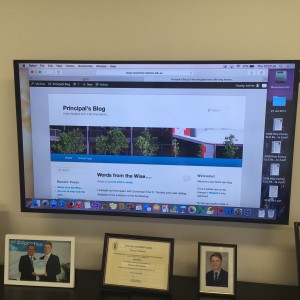Ten years ago when we were installing the latest form of presentation technology at the time, the so-called “interactive Whiteboards” we were removing the “old” fixed static White Boards. When the staff were lifting off the White Boards from the walls, in some places lo and behold they found their predecessors ..blackboards.
As it happened, we quickly found that the Interactive Whiteboards were not so interactive after all. Four years ago we moved to Screens which truly enabled learning interactivity among stakeholders adult and children alike.
The introduction of the screens was preceded by establishing an extensive wireless network which we saw as an essential element in launching the emerging technologies which we could forsee in the future. The trends were clear, miniturisation and portability of devices and a focus on the personal rather than shared devices.
It is interesting in education that there is often a gulf between the perceived purpose of an innovation and the actual outcome in schools. One of the traps for the unwary seems to be when technologies are developed and schools try to fit themselves around them.
In our case the screens fitted hand in glove with our pedagogical predispositions. We went looking for the screens not the reverse where someone sought to sell something to us. In one sense we wanted to wrest the chalk from the hands of the teacher and share it around a bit.
These days children and adults use the screens seamlessly to present and share their learning. The various learning areas have access to a range of screens of different sizes placed in various positions. We have an outside screen beaming information out to the community, a huge screen in the Hall suitable for sharing learning with large groups.
I was anxious that the screens should not be a simple electronic substitution for the previous static forms of presentations. We wanted to move from pedagogy which operates basically the same way it did before computers were developed to pedagogy which simply unattainable without computers. In this we way we are being truly transformational. As Ruben Puentedura describes the process it is about moving the use of technology from Substitution to Augmentation to Modification and finally to Redefinition (Known a the SAMR Model)
Interestingly, other schools who resisted our early promotion of using screens in the classroom are now taking them up. The real challenge, as I say, is allowing the students to use the technology to be resilient agents of their learning.

Figure 1. The screen in my office to which a five year old referred recently announcing he was going to bring in his device, connect to the screen and show me his learning
The latest iteration in the use of Screens is to use the new Samsung magic info which enables dynamic imaging of learning in a class controlled by a teacher loading and storing images on the network and using to post images celebrating learning achievements or providing provocations for new learning.
All learners at Holy Family use their devices (iPhones, iPads and Laptops) to connect wirelessly via Apple TV to share and celebrate their learning. The screens proliferate in our school with three in most learning areas, some in leaders rooms and large LED screens strategically placed for large audiences and lots of ambient light.